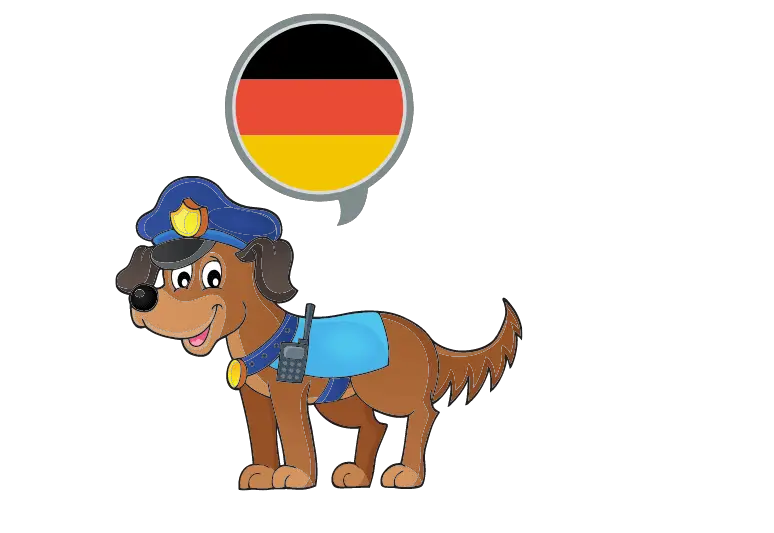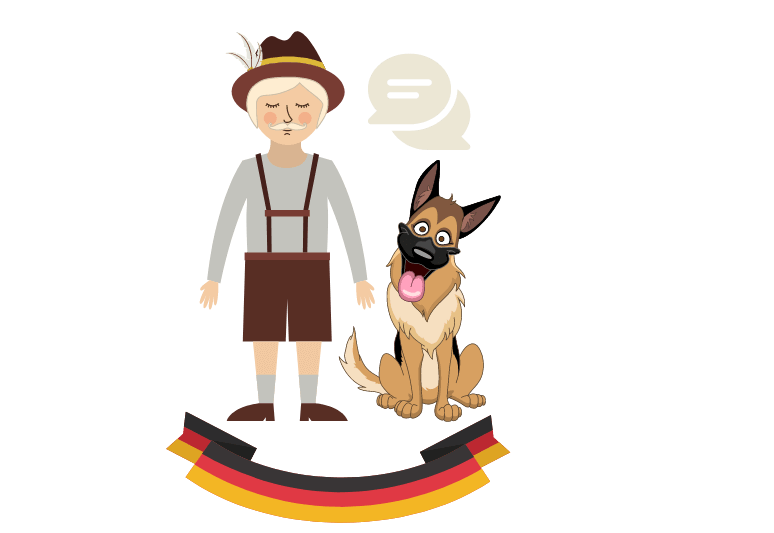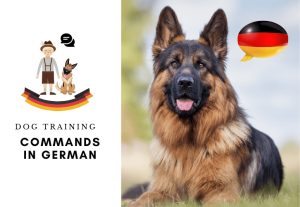If you are looking for a list of the best German dog commands, you have come to the right place. This article provides the most important German commands for dogs, including pronunciation and translation.
In addition, an infographic is available which can be saved directly to your phone. This ensures that you always have the most important dog training commands in German at your fingertips.
Keep reading to discover them all!
Are German Commands Better for Dogs?
There is no definitive answer to this question, as it depends on the individual dog and its owner. Some dogs may respond better to German commands, while others may do better with English commands. It is important to find what works best for you and your canine companion.
If you are training for Schutzhund, it may be beneficial to use German commands, as this is the language used in the sport. Ultimately, the most important thing is that the dog owner is consistent with their commands, regardless of which language they use.
What Are The Best German Commands for Police Dogs?
Police dogs are trained to obey commands in German because the commands are short and straightforward, leaving no room for ambiguity.
Here is a list of the best German commands to use when training your dog:
- Back up: Zurück (Zu-ru-kh)
- Bark / speak: Gib Laut (Gheb Laout)
- Bite / attack: Fass (Fass)
- Blind search: Revier (Re-fieer)
- Come / here: Hier (Heeee-ar)
- Crawl: Kriechen (Kri-khen)
- Down: Platz (Plah-tzz)
- Eat / take your food: Nimm Futter (Nim Futter)
- Fast: Schnell (sh-nel)
- Fetch: Bring (Bring)
- Find narcotics: Such Rauschgift (Sooo-kh Raush ghiift)
- Go inside: Geh Rein (Gay rine)
- Go out: Voraus (For-owss)
- Good (praise): So ist Brav (so ist braf)
- Good job: Gut Gemacht (Goot ghem-akht)
- Good dog (praise): Braver Hund (Braffer Hoond)
- Growl: Brummen (Broomen)
- Guard: Wache (Wa-khe)
- Heel: Fuß/Fuss (Foos)
- Howl: Heul (Hoo-el)
- Jump / up: Hopp (Hooop)
- Kennel: Zwinger (zwingher)
- Leave it: Lass es (Lass es)
- Left: Links (Links)
- Let go / out: Aus (Awuss)
- Look at me: Schau mich an (Shao mikh an)
- No / stop that! (correction): Nein, Pfui (Nine, Pfoooey)
- Ok / everything alright: In Ordnung (In Ordnungh)
- Outside: Raus (Raus)
- Paw / shake: Pfote (Fote)
- Quiet: Ruhig (Roo-hig)
- Right: Rechts (Rekh-ts)
- Search / find / track: Such (Sooo-kh)
- Find lost article: Such Verloren (Soo-kh Ferloren)
- Sit: Sitz (Ziits)
- Slow: Langsam (lang-zam)
- Stand: Steh (Sh-teh)
- Stay calm / stand still: Bleib Ruhig (Blibe rooegh)
- Stay: Bleib (Bliibe)
- Stop: Halt (Halt)
- Take it: Nimm (Nimm)
- Touch: Berühren (Be-ru-ren)
- Treat: Leckerli (Lek-erli)
- Wait: Warten (Varten)
- Walk / run: Lauf (Lauf)
- Watch / pay attention: Achtung (Akh-toongh)
- What is going on?: Was ist los? (Vas est Loos?)

There are lots of other dog commands in German, but these are the most common.
Why Should I Use German Commands With My Dogs?

When it comes to training your dog, certain German commands seem to be more effective than their English counterparts. This is likely due to the fact that German commands are less arbitrary.
Personally, I use German commands with my dogs during all training sessions and walks. I prefer German for three main reasons:
- I lived in Germany for six years and started my first intensive dog training courses there.
- German is a more authoritative language.
- When another person calls their dog with “come”, my dog does not react because I use a language with my dog that most people do not speak.
You do not have to learn German, but you can use these German commands as examples and choose the ones you prefer.
Common Mistakes When Using German Commands
Using German commands can be an excellent tool in dog training, but certain mistakes can hinder their effectiveness. Here are some of the most common mistakes and tips to help you avoid them:
- Inconsistent Use: Consistency is crucial in dog training, and this applies to German commands as well. Inconsistent use of German commands can lead to confusion for your dog, so it’s essential to use them consistently and always in the same context. Establishing a routine and sticking to it will help your dog understand what you expect from them.
- Incorrect Pronunciation: Proper pronunciation of German commands is essential for effective communication with your dog. Mispronouncing German commands can cause confusion and make it more difficult for your dog to learn. It’s important to learn the correct pronunciation and use it consistently. You can use online resources to find the correct pronunciation of German words and practice saying them out loud until you feel confident.
- Lack of Positive Reinforcement: Dogs respond best to positive reinforcement, such as treats or praise. If you fail to reward your dog for following German commands, they may be less likely to obey them in the future. It’s essential to reward your dog immediately when they obey a command. This will help them understand what you expect from them and make them more likely to obey in the future.
- Overuse of Commands: Using German commands too frequently can also lead to confusion and may cause your dog to become desensitized to them. It’s important to use German commands only when necessary and to use other cues and signals as well. Overusing commands can make them less effective and may cause your dog to lose interest in training. It’s important to keep training sessions short and frequent and to use a variety of cues and signals to keep your dog engaged.
By avoiding these common mistakes and following the tips provided, you can effectively use German commands to train your dog. Remember, training your dog takes patience, consistency, and positive reinforcement. With proper training, your dog will learn to understand and obey German commands, making training easier and more effective.
Pronunciation Guide for German Dog Commands
Learning the correct pronunciation of German dog commands is essential for effective communication with your dog. Here are some tips to help you pronounce German commands correctly:
- Use a Pronunciation Guide: You can find online resources that provide the correct pronunciation of German words and phrases. Practice saying the words out loud until you feel confident in your pronunciation.
- Record Yourself: Recording yourself saying the German commands can help you identify areas where you need to improve your pronunciation.
- Practice with a Native Speaker: If possible, practice saying the German commands with a native speaker. They can provide feedback and help you improve your pronunciation.
Below you can find a list of commands, along with their pronunciation and meanings.
| German | Pronunciation | English |
|---|---|---|
| Sitz | Ziits | Sit |
| Platz | Plah-tzz | Down |
| Bleib | Bliibe | Stay |
| Aus | Awuss | Let go / out |
| Hier | Heeee-ar | Come / Here |
| Steh | Sh-teh | Stand |
| Bring | Bring | Fetch |
| Hopp | Hooop | Jump / up |
| Voraus | For-owss | Go out |
| Such | Sooo-kh | Search / find / track |
| Wache | Wa-khe | Guard |
| Gib Laut | Gheb Laout | Bark / speak |
| Fass | Fass | Bite |
| Such Rauchgift | Sooo-kh Raukh ghiift | Find narcotics |
| Revier | Re-fieer | Blind search |
| Geh Rein | Gay rine | Go inside |
| Was ist los? | Vas est Loos? | What is going on? |
| Braver Hund | Braffer Hoond | Good dog (praise word) |
| Lass es | Lass es | Leave it |
| Such Verloren | Soo-kh Ferloren | Search lost article |
| Bleib Ruhig | Blibe rooegh | Stay calm / Stand still |
| Nimm Futter | Nim Futter | Eat / take your food |
| In Ordnung | In Ordnungh | Ok / everything alright |
| Nein, Pfui | Nine, Pfoooey | No / stop that!(correction word) |
| Fuß/Fuss | Foos | Heel |
| Fass | Fahss | Bite / Attack |
| Nimm | Nimm | Take it |
| Achtung | Akh-toongh | Watch – pay attention |
| Warten | Varten | Wait |
| Rechts | Rekh-ts | Right |
| Links | Links | Left |
| Berühren | Be-ru-ren | Touch |
| Pfote | Fote | Paw / shake |
| Kriechen | Kri-khen | Crawl |
| Züruck | Zu-ru-kh | Back up |
| Brummen | Broomen | Growl |
| Heul | Hoo-el | Howl |
| Halt | Halt | Stop |
| Gut Gemacht | Goot ghem-akht | Good Job |
| Leckerli | Lek-erli | Treat |
| Zwinger | zwingher | Kennel |
| So ist Brav | zo ist braf | Good (praise) |
| Schnell | sh-nel | Fast |
| Langsam | lang-zam | Slow |
| Ruhig | Roo-hig | Quiet |
| Nimm | Nim | Take it |
| Shau mich an | Shao mikh an | Look at me |
| Lauf | Lauf | Walk / Run |
| Raus | Raus | Outside |
Tips for Using German Commands With Your Dog
When it comes to using German commands to train your dog, it’s important to keep in mind some tips to make the training process more effective. Here are some additional details on the tips mentioned earlier:
- Use Positive Reinforcement: Positive reinforcement is a powerful tool in dog training. Dogs respond best to rewards, such as treats or praise, which motivates them to repeat the behavior that earned the reward. When your dog obeys a German command, immediately reward them with a treat or praise to reinforce the behavior.
- Be Consistent: Consistency is key in dog training. Dogs learn through repetition and consistency, so it’s important to use the same German commands in the same context to avoid confusing your dog. This means that if you use a particular command for a specific behavior, use that command consistently every time.
- Start with Basic Commands: It’s best to start with basic German commands when training your dog, such as sit, stay, and come. These commands are easy for your dog to understand and learn and form the foundation for more advanced commands. Once your dog has mastered these basic commands, you can move on to more complex commands.
- Keep Training Sessions Short: Dogs have short attention spans, so it’s important to keep training sessions brief and frequent. Short, frequent sessions of 10 to 15 minutes a few times a day are more effective than one long session. This helps keep your dog engaged and focused, making the training process more effective.
By following these tips, you can effectively use German commands to train your dog. However, it’s important to keep in mind that training your dog takes patience, consistency, and positive reinforcement. With proper training, your dog will learn to understand and obey German commands, making training easier and more effective.
How to Introduce German Commands to Your Dog
Introducing German commands to your dog can be a fun and rewarding experience. This process requires patience, consistency, and positive reinforcement to help your dog understand and obey your commands. Here are some steps to help you get started:
- Start with Basic Commands: Begin with basic commands, such as sit, stay, and come. These commands are easy for your dog to understand and learn and form the foundation for more advanced commands. Use treats and praise to reward your dog for obeying the commands.
- Use Gestures: Accompany the commands with hand gestures or body language. This helps your dog understand the command even if they don’t understand the language. Using gestures or body language can help your dog learn more quickly and easily.
- Be Consistent: Consistency is key in dog training. Use the same German commands in the same context to avoid confusion for your dog. It’s important to use the same language consistently so that your dog can learn to associate the commands with specific actions.
- Gradually Introduce New Commands: Once your dog has mastered basic German commands, you can gradually introduce more advanced commands. Start with commands that are similar to the basic ones your dog has already learned, and gradually increase the difficulty. This will help your dog feel more confident and motivated to learn new commands.
It’s important to remember that training your dog takes time and effort. Consistency and positive reinforcement are key to helping your dog understand and obey your commands. With patience and persistence, your dog will learn to understand and respond to German commands, which can make training easier and more effective.
In addition to these steps, there are other things you can do to help your dog learn German commands. For example, you can use a clicker to help your dog associate the command with the desired behavior. You can also use treats to reward your dog for obeying commands, and gradually reduce the number of treats as your dog becomes more proficient.
Learning German commands can be a great way to bond with your dog and teach them new skills. Whether you’re interested in training your dog for Schutzhund or just want to impress your friends with your linguistic skills, introducing German commands to your dog is a fun and rewarding experience.
Frequently Asked Questions About Dog Training Commands in German

Conclusion
If you want to learn any other dog training command in German, please let me know.
REMEMBER: Training a dog means understanding how to communicate with them. This is the most important part of training any dog, and it involves learning how to speak their language, not the other way around.
If you enjoyed the article, please share it.
Thank you for reading, and have a great day!
Until next time.
You may also like…





